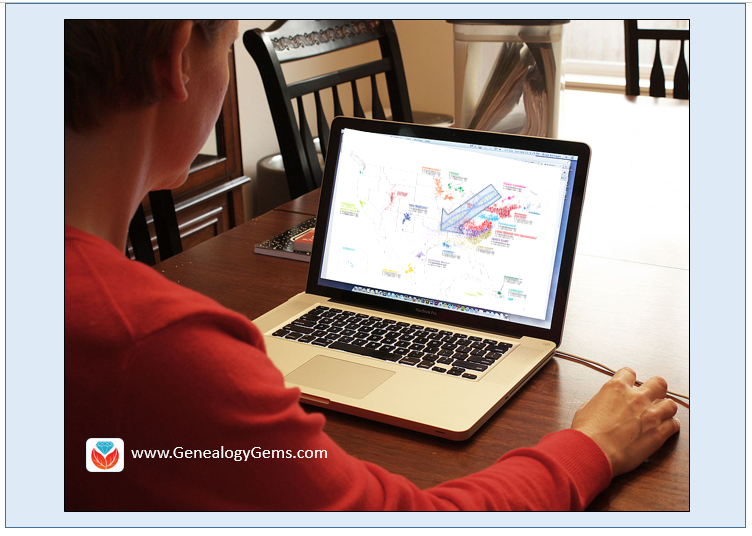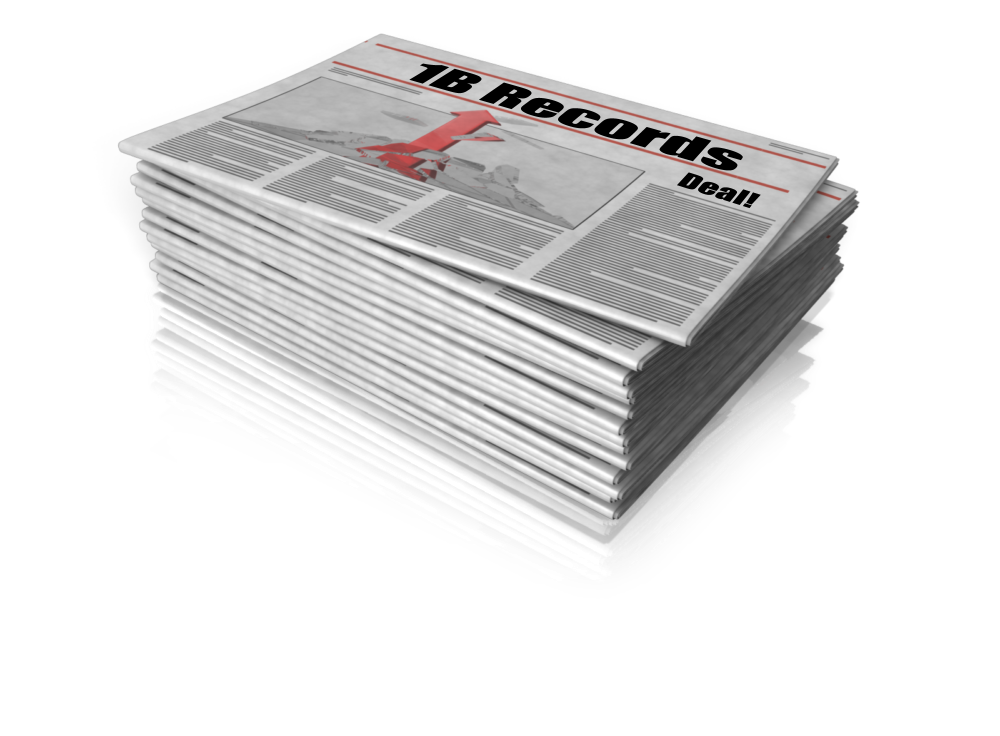by Lisa Cooke | Mar 13, 2017 | 01 What's New, DNA
Do you need help solving your family migration patterns? A groundbreaking new scientific study uses DNA and family trees to map migration routes across North America.

Family Migration Patterns Revealed in Genomes
A new study published in Nature Communications represents a ground-breaking development in using DNA for genealogy. The article from the AncestryDNA Scientific Team is titled Clustering of 770,000 genomes reveals post-colonial population structure of North America. Or, in more understandable terms, “Your DNA can tell us where you came from in America in the last 500 years.”
Wow, right? So, how did they do this?
The power really is in the numbers. In this particular paper, they started with using their autosomal DNA test on 770,000 people. Some of them were AncestryDNA customers who had consented to be part of the research. From these 770,000, they learned quite a bit about the migration patterns of early Americans. As Ancestry analyzes more individuals using these same principles of correlating genetics and genealogy, this data will improve and be able to tell us even more about our heritage. Even though it takes a large data set to figure out the relationship between our DNA and migration patterns, it really comes down to the relationship of two people.
To start, Ancestry determines how just two people are genetically related. Then, they find how those two are related to a third person, again, looking only at pairs of people. This goes on and on until everyone in the group as been compared. They use a graph to plot those relationships, with those more closely related clustering around each other. And then it happens. The point where we see the marriage of genetics and genealogy suddenly appear by adding in the family history information for each of these individuals in the cluster.
What they found was astounding. They have displayed the data in Figure 3 shown below. It is a map of the United States with colored dots scattered across the landscape. The location of the dots corresponds to the genealogy of those tested, while the color of the dots relates to their genetic clustering. Those who cluster closest together are the same color. The result is a nearly perfect rainbow, with buy anti anxiety medication online uk each color holding its respective spot on the map, with very little overlap between groups.

Distribution of ancestral birth locations in North America. Summary map from Nature Communications; click to see article with full explanation of map data. Image used with permission of Ancestry.com.
We might be tempted when looking at the map to think, oh, well, of course there is a large population of European Jews in New York, everyone knows that. But this isn’t their family history, their accent, or their culture telling us this – it is their genetics!
As if that wasn’t exciting enough, the scientists describe how we can trace family migration patterns of different groups over just a few generations. They specifically mention French Canadians and Cajuns/Acadians, but the same principle can theoretically be applied to dozens of other groups.
Family Migration Patterns and Applying these Findings
 So what does this mean for you as a genealogist?
So what does this mean for you as a genealogist?
It means we are getting closer than ever to being able to tell who you are and where you came from using your DNA.
For example, let’s say you have an ancestor in Texas about 4 generations ago, but you aren’t sure where she came from. Your DNA could tell you that you fit into the Lower South group, meaning that your ancestor likely hails from the south. Or, maybe your genetics identify with the Upland South, which means you need to explore records from Arkansas, Tennessee, and North Carolina.
This is just a glimpse into the advances that genetics are bringing to your genealogy toolbox these days. So it’s high time to go “all in” to learn about genetic genealogy! We recommend The Family Tree Guide to DNA Testing and Genetic Genealogy by Blaine Bettinger. You’ll love this book if:
- You’ve got brick walls that traditional research methods haven’t been able to break down
- You want to take advantage of the hottest tool in genealogy
- You’ve already taken a DNA test and want to know what comes next
Disclosure: This article contains affiliate links and Genealogy Gems will be compensated if you make a purchase after clicking on these links (at no additional cost to you). Thank you for supporting Genealogy Gems!
by Lisa Cooke | Sep 11, 2013 | 01 What's New, Ancestry, FamilySearch, Records & databases
Ancestry.com and FamilySearch International, the two largest online providers of genealogy data, just announced an agreement that’s expected to put a billion more historical records from around the world within reach online.

FamilySearch and Ancestry: Billion Record Deal
A billion is a LOT of records. If you wanted to count to a billion, it would take you 95 years.
According to an Ancestry.com press release, the organizations will partner “with the archive community over the next five years to digitize, index and publish these records from the FamilySearch vault.”
“The access to the global collection of records marks a major investment in international content as Ancestry.com continues to invest in expanding family history interest in its current markets and worldwide,” continues the release. “Ancestry.com expects to invest more than $60 million over the next five years in the project alongside thousands of hours of volunteer efforts facilitated by FamilySearch.”
This kind of collaboration (rather than competition) between these two enormous organizations will likely mean fabulous fruits for the genealogist. I love that the emphasis is on worldwide records, too. Though people in certain international markets may be the ones using their records, the ancestors of those folks have come from all parts of the world. As always, stay tuned to Genealogy Gems to hear news like this and for updates as these records start becoming available.
by Lisa Cooke | Feb 19, 2014 | 01 What's New, Family History Library, FamilySearch, Libraries, Research Skills
Those who just attended RootsTech 2014 probably wish they’d had more time for researching at the Family History Library. Others may have watched streaming sessions of RootsTech at satellite Family History libraries, called Family History Centers or FamilySearch Centers. Whatever the case, I’m guessing many of us wish we knew more about how to use the Family History Center (FHC) nearest us.
FHCs are great: they’re free, there’s usually one not too far from you, they are your personal portal to microfilmed content at the Family History Library, and you don’t have to be a member of the sponsoring LDS church. And as it happens, I’ve just republished a three-part series on FHCs from my original Family History: Genealogy Made Easy podcast. All three episodes feature longtime genealogy researcher Margery Bell, Assistant Director of the Oakland Family History Center in Oakland, California. Here’s a breakdown of topics covered in each episode. Click on each to see the episode webpage, where you can access the podcast and the show notes.
Episode 17: Introduction to Family History Centers, their local holdings and how to order and use microfilmed resources from the Family History Library.
Episode 18: How to prepare for a visit to a local Family History Center, subscription websites you can use for free while visiting, and making copies in all forms.
Episode 19: Educational opportunities available through Family History Centers and Margery’s 7 top tips for getting the most out of your visit. Bonus: Margery shares inspiring stories of genealogy serendipity that happens when researchers come together in person.
by Lisa Cooke | Feb 11, 2014 | 01 What's New, Family History Library, Family History Podcast

Listen to the Family History: Genealogy Made Easy podcast by Lisa Louise Cooke. It’s a great series for learning the research ropes and well as refreshing your skills.
Originally Published 2009
Republished February 11, 2014
https://lisalouisecooke.com/familyhistorypodcast/audio/fh18.mp3
Download the Show Notes for this Episode
Welcome to this step-by-step series for beginning genealogists—and more experienced ones who want to brush up or learn something new. I first ran this series in 2008-2009. So many people have asked about it, I’m bringing it back in weekly segments.
Episode 18: Using Family History Centers, Part II
This episode is the second in a series about Family History Centers, the regional satellite facilities of the main Family History Library in Salt Lake City, Utah.
My very special guest is friend of the show Margery Bell, Assistant Director of the Oakland Family History Center in Oakland, California. Last week Margery Bell introduced us to the Family History Center, and walked us step by step through the process of ordering and using microfilm. She also discussed the wide range of resources beyond microfilm that you will find at both your local Family History Center and one of the 14 larger regional centers.
In our first segment in this episode she preps us for our visit and reveals the subscription websites you can use for free at Family History Centers. Then in our second segment, Margery discusses making copies in all forms, the future of digitizing microfilm, and the future of Family History Centers.
We also talk about tips for visiting the main Family History Library (see link below and link to Show Notes, above).
In next week’s show, part three of the series on Family History Centers, Margery Bell will talk about educational opportunities through the centers, she’ll give us her 7 top tips for getting the most out of your visit, and we’ll wrap up with some wonderful inspirational stories of genealogical serendipity.
Updates/Links
- Some Family History Centers are now called FamilySearch Centers. Many Centers have opened in public and private libraries in the past few years, not just in meetinghouses of the Church of Jesus Christ of Latter-day Saints. Click here to find a FamilySearch Center/Family History Center near you.
- Many records are now available online, either in indexed form or just the digitized images. Click here to visit the online catalog of the Family History Library. When you find something you’d like to order, look at the catalog entry. If it’s digitized and online, you’ll see a link.
- Many of the same principles apply to visiting the Family History Library and Family History Centers. Click here for updated information about preparing for your visit to the Family History Library (this is instead of the handout mentioned in the podcast).
- Here’s a link to the main Family History Centers page on the FamilySearch website, which has an updated list of databases available there (and a lot more information).


 So what does this mean for you as a genealogist?
So what does this mean for you as a genealogist?

